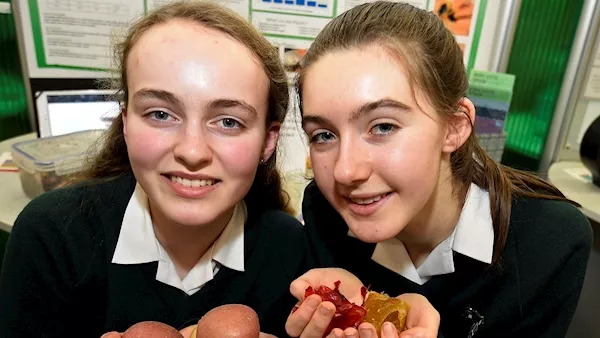They're growing food on the moon, they've created plastic packaging from potato skins and they've built robots to distribute pollen - these are just some of the solutions that Ireland's young scientists have come up with.
On day two of the 55th BT Young Scientist and Technology Exhibition in Dublin's RDS, thousands of visitors swarmed around the 550 projects to catch a glimpse of the future.
Transition year students from Cork's North Monastery Secondary School drew lots of attention with their 'Ro-Bee,' a robot that can be used to pollinate the world's plants, as bees are slowly dying out.
"About 70% of all crops worldwide are affected by bees, they're pollinated by bees, so if bees die out then they won't be pollinated, so we won't have any crops," explained Jordan Woodgate.
"How we envision it working, is first making it a drone structure, something that can actually fly, that'll suck up the pollen and it would store it in a storage tank and then when it reaches a certain capacity it could spray the pollen on to other flowers. A drone could work even more efficiently than the bee," said Paul Sunday.
The reason their project is drawing such attention is because the decline in the world's bee population is potentially devastating.
We found that in some parts of China the bee is completely gone altogether. And over here in Ireland, a third of all bees species are threatened with extinction.
"So there's a massive decrease. And over in America, $30m worth of crops were destroyed because they weren't pollinated by the bees," Brian Prout said.
Also focusing on the environment, a topic that was hard to miss at the exhibition with nearly 20% of all projects exploring climate change, is one creating plastic from food waste.
Second year students, Rachel Ingle and Aoife McMahon from Santa Sabina Dominican College in Dublin, have been visited by several government ministers as their project, turning food waste in bioplastic, is turning lots of heads.
"We tested our plastic for compostability, recyclability, its melting point and if it's waterproof and it is 100% compostable and recyclable and waterproof," said Rachel.

Aoife McMahon and Rachel Ingle from Santa Sabina Dominican College with their project.
Giving away their foolproof formula, which has a goo-like consistency before it sets, is Rachel's science partner, Aoife McMahon.
"What you need to make our plastic is just potato starch (potato skins), white wine vinegar, vanilla extract, just to get rid of the vinegar because vinegar doesn't have a very nice smell and glycerine to make it gooey. And we just need food colouring just to give it a nice colour," explained Aoife.
The students made both hard and soft products from their bioplastic, creating a spoon and some sheet packaging.
"You could potentially use this, the thin version, as wrapping or food packaging. Potentially, in the long run, you could make boxes out of it as well," said Rachel.
Staying with food, but this time focusing on growing it in space, is a project from third year students at Coláiste Chiaráin, in Limerick, Oisin Brady Halmschlag and Kevin Lawlor.
They have designed a farming system that will enable humans to live on the moon, and maybe even Mars, allowing them to grow food without soil.

Oisin Brady Halmschlag and Kevin Lawlor of Coláiste Chiaráin, Limerick, with their project to design a hydroponic system for sustainable plant growth on the moon.
"Our project is about growing plants on the moon in a sustainable way," said Oisin.
We were looking up stuff about NASA and we see they are planning on returning to the moon again soon. So we were thinking why spend all that money if they're just going to come straight back down again?
"With this they can stay up there for a prolonged period of time, maybe set up a permanent habitat and then work to get to Mars as well."
"Currently we are growing lettuces and radishes, but in the future we plan to grow stuff that has more nutritional value like potatoes and turnips," said Kevin.
Back down on earth, three Cork students have taken the fear, and danger, out of foraging, allowing people to potentially pick mushrooms, while knowing which are poisonous and which are not.
Alice Sexton, Hannah Rafferty and Aibhín Ruddy, from Sacred Heart Secondary School in Clonakilty explained their project to the Irish Examiner.

Michael Martin with Aibhín Ruddy, Hannah Rafferty and Alice Sexton from Sacred Heart Secondary School Clonakilty. Photo: Kenneth O Halloran
"We are coming up with simpler ways to identify mushrooms. We have an Instagram page called @fear.free.foraging and on there we do awareness posts. We've done posts on psychoactive mushrooms, one on mushroom identification, common species, and toxins," said Aibhín.
"We would advise, unless you have done your research, not to go near the mushrooms, because 20% to 25% are poisonous in Ireland and there are 2,000 species," said Alice.
"That's roughly 500 mushrooms that have the potential to harm you," added Hannah.
The BT Young Scientist & Technology Exhibition is open to the public, in Dublin's RDS until Saturday.






